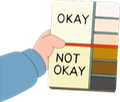I’m joking with the meme, but it’s an interesting how plot armor unintentionally places value on people’s lives in fiction.
It’s telling that censorship laws decide who it is and isn’t acceptable to kill. Just thinking about violence against sentient robots and how that’s normalized in things like Samurai Jack.
Like we know the robot has thoughts and feelings, like they’ll try to run to save themselves or plead for mercy, but a character can still heroic after essentially killing a non-human who’s acting like how we understand humans.
I feel like there’s something dangerous in how easily we can depict appropriate targets of violence. Not just robots, but anybody deemed as less than human are allowed to be more put at risk.

Unnamed people are killed in superhero fights all the time. But unless they are of a class of characters like protagonists, they are collateral damage at best.
I think Plot Armor as a trope needs more class consciousness and awareness around how deciding who gets to be protected is often an unconscious political belief.
What about you though? Any tropes in media you’d like to see explored more or written with a leftist understanding?


Basing a fantasy culture off of a real-life culture. Or even worse, basing a fantasy race off of a real-life culture - that’s just dehumanization. It’s very common, it’s very problematic, and it’s a remnant of racist 20th century fantasy. The Forgotten Realms has to be destroyed, sorry. Genshin Impact as well.
If you’re going to be using a real-life culture, you need to seriously know your stuff and have respect for the culture you’re writing about (this is why Liyue is good and Sumeru is racist trash, for instance). I’d say to most people that if you want to use someone else’s culture cause it’s cool, consider worldbuilding something unique instead and save us all a headache.
What’s really problematic is when they just have race wars in there, as a thing, and it’s not examined at all. For all the things BG3 does well, it treats the goblins as completely disposable even within the narrative itself. There’s deep gnome characters who live on the surface in Baldur’s Gate, but every single goblin is a football hooligan that eats people and can’t read. All they’re good for is being slaughtered by the PC or slaughtering all the Tieflings at the grove.
Before I knew what The Absolute was, the goblin woman in the cage had my sympathy and I sincerely wanted to find out what she was talking about and set her free because leaving her in there to be inevitably killed just seemed pointlessly cruel.
I’m not saying The Absolute had to be some wholesome goblin leftist revolutionary front that would overthrow the rich assholes of Waterdeep or something, but the single note “these are ugly bad people that do bad things” messaging was really, really lazy.
Pathfinder goblins have a lot more nuance even while still being generally unruly and seen in an ungenerous light.
Wild that BG3 literally removed alignments and still made 99.9% of golbins evil
The game was generally good but the setting presented still has some pretty sus takes and messaging.
I never run “official” campaign settings and never have because I’ve always found Forgotten Realms pretty sus and sort of designed around some shitty old ideology with a lot of inertia and status quo maintenance mechanisms built right in.
I’ve even moved on to Pathfinder for that reason. Fuck WOTC and its every few years attempts to force worse licensing agreements on everyone else.
gang
What’s worse is that if you do free Sazza and bring her to Minthara, she immediately betrays you and encourages Minthara to kill you instead of rewarding you for freeing her and letting her report where the Grove is, and she gets fed to the spiders.
Because goblins born evil according to Gygax all the way back in the 70s and pretty much every representative in the modern game reinforces that but at least every single party member may be bisexually horny for you so progress I guess.
If they really wanted progress they should have let us bone some green shortstacks instead of making every goblin take the volcel oath
yeah, like making a completely new culture that’s unrecognizable from it’s inspirations is fucking hard, i’m sympathetic to taking liberties and making a country ‘magic italians’ or something. but your fantasy cultures should never be doing a fucking race war unless its industrialized, colonial and the story is all about examining that.
medieval and ancient people didn’t do race war, they didn’t have the ideological bases to even imagine it
Medieval group atrocities were usually religion-based. The Protestant movement motivated a lot of bloodshed, and medieval Christians were real big on Jewish pogroms for damn near anything that might happen. Plague? Famine? Bandit raid? Blame the Jews, have a pogrom. Hell, they did it for recreation sometimes.
To that end I’m kinda using that approach in my own stuff (spoilers for autistic infodumping about my writing that I’m procrastinating on)
spoiler
In the setting I’m writing, a theocratic nation led a genocide of the orcs and goblins after ancient elven magitek industrialization allowed religious political power to fester into religiously-grounded protofascism, and the theocratic leaders were upset with how the nomadic tribes of orcs were interfering with their land grab and also selling their mercenary services to other nations, and of course settled insular goblin communities had worked hard to carve a niche for themselves and monopolize certain specialized trades that industrial barons were keen to take control of so they had to go. Heretics, all of them, offensive to the sight of the human-coded pantheon. After war and famine and magical disasters ravaged a lot of the other populations as well, the remaining orcs and goblins, absolutely mad with lust for revenge, were instrumental in the big multiracial peasant revolution that killed all the nobles and priests that were left and started managing the multiple simultaneous apocalyptic crises unleashed upon the continent.
Also two of the crew of the airship I’m setting it on are from Not-France and speak Not-French and Not-France is the center of remaining Not-Europe culture because they were relatively unscathed by the never-ending lightning storms and time ruptures and roving self-perpetuating undead hordes so they still got their universities and theaters and salons and whatnot, so yeah just slapping some aesthetics on there to get the job done is fine in small doses but it’s no fucking excuse for not examining everything and making sure it all fits together and feels true and isn’t some fucked up bullshit that inadvertently says some heinous shit
thing with religious wars is they can very quickly find a modus vivendi in the right circumstances, or at the very least a conversion is an immediate reprieve for the victims—which like isn’t ideal and arguably cultural genocide but it’s a ways from racial extermination.
Protestants were part and parcel to the development of racism though, because the reformation was a time when skepticism of conversion became culturally endemic instead of the private purview of inquisitorial staff. the way the hatred & suspicion of catholics was transposed into racism against irish people was through the “cryptocatholic” panics of early anglicanism, which supplied an excuse to dispossess even the converted irish. come to think of it that would be a cool place for fiction to explore ‘racism doesn’t quite exist yet, but we’re working on it’
Thanks for the compliment
Yeah, I’m still working out the details of this and that. What I really need to focus on is finish the story I’ve been working on since the start of this year. I keep telling people about it instead of writing it.
Tolkien’s thing exploring the extremes of humanity as different races was cool. Except there was way too much overlap with real world races that invalidates it for me.
The former is what humans have been doing in mythology since the beginning of civilization. The latter is modern mythology, basically nationalism and fascism in the worst case. There is a reason that neo-Nazis use the term “orc” for people they consider inferior
How did Tolkien explore the extremes of humanity through different races? Lord of the Rings may give thst impression somewhat and the Jackson films quite a bit but on other works elves have quite a variety of cultures and different types of dudes including one of the biggest assholes of the legendararium, Feanor. The dwarves still seem a bit like a monoculture but Tolkien didn’t write a tonne on them and they keep a lot of their culture secret to non dwarves. Children of Hurin has examples of characters form all of those races who act against what would become the stereotype (it didn’t exist yet, it came from people who were inspired by Tolkien). This may just be me being a giant Tolkien geek and from reading everything the guy ever put to paper at least twice.
Yes you are right, there is a lot of internal diversity within elves and dwarves. That is a saving grace, and not just that, it should serve as direction for modern fantasy writers too who might otherwise overlook the scope of Tolkien’s project as the first fantasy work, and write monoliths and stereotypes instead.
I am trying to recall exactly where I read Tolkien explaining this. Maybe the Silmarillion or one of his letters, or I might be remembering someone else’s explanation. Basically the observation that in mythology, subsequently reflected in Tolkien, supernatural races are in fact human but to an extreme in some respect.
Like the elves represent the daring and heroic of humanity, once young, powerful, and immortal in a new world, then weary of it once past the point of glory. The dwarves are humanity’s drive to build and conquer nature, to an obsessive degree. Orcs are humans twisted by industrialization and warfare. Hobbits are humans stubborn yet content in their traditions, maybe fearful of change as well.
You see the same across mythologies, which I believe Tolkien was aware of. In Indian mythology, the gods and gandharvas are humans with extreme power, virtue, knowledge, and compassion. The asuras are the same, but without compassion. Rakshasas are asuras without the virtue and knowledge. Pretas are hungry and all-consuming. The apsaras are sexual and playful. And so on. They are all humanoid, even the ones which aren’t, paradoxically, like the nagas, kinnaras, and kimpurushas.
All put together, at least in the Indian conception, they are all characters in a divine drama, meant to celebrate or teach the human condition to the human audience.
I see what you mean there. I’d have to guess it’s someone else’s explanation though. It’s for sure not in the Silmarillion or published letters and it doesn’t sound like how Tolkien considered his own work. He may have had that influence but his ‘anti allegory’ (big quotes) brain would just deny it. It’s both there and totally subverted at the same time, actually, yeah, that does kinda cover it, I can’t think of a character or story in the legendary that doesn’t apply to and even thematically it does both all the time every time.